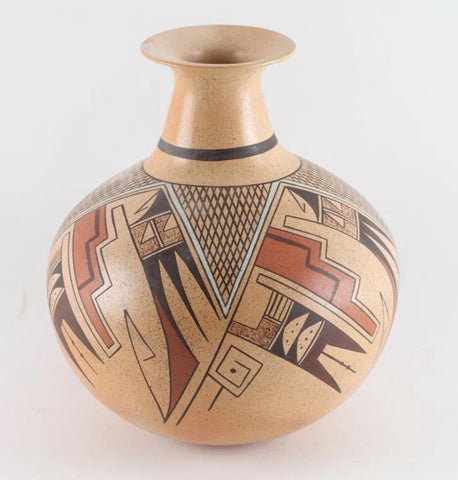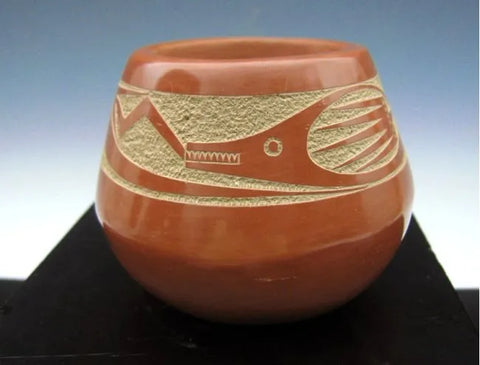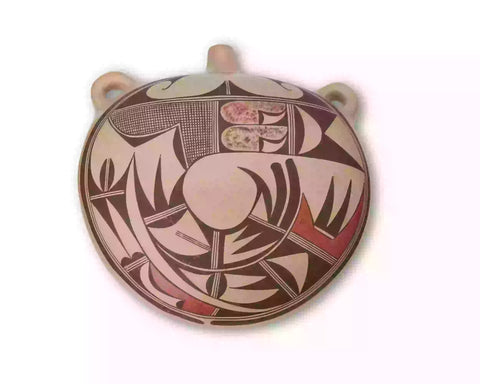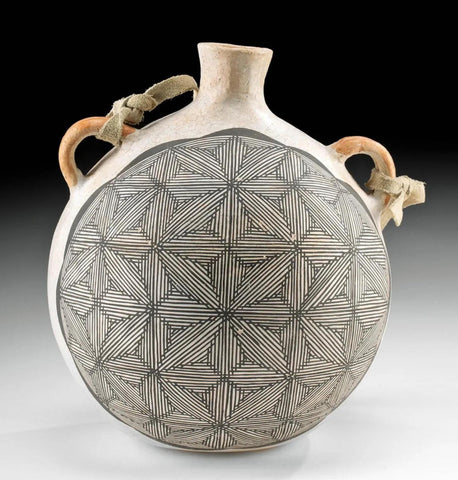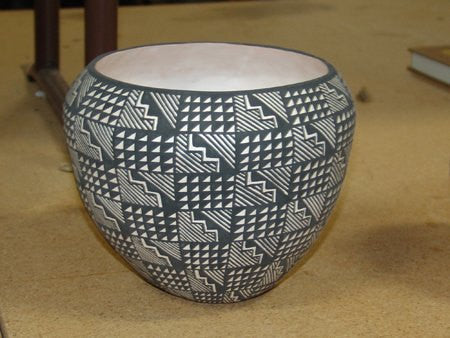
Acoma Pottery : Very Good Black on White Acoma Pottery Jar by Tina Garcia #393 a SOLD
$ 325.00
Acoma Pottery
393 a. Late 1900's finer black-on-white pot with geometric design. 4 3/4" x 5 1/4". Very good condition.
Tina was born in Oregon in 1957 and moved to Santa Clara Pueblo at the age of 5. Growing up, she watched her mother, Lydia Garcia; grandmother, Severa Tafoya; and aunt, Angela Baca, make black pottery. She started potting herself at the age of 11 and showed much early talent which was encouraged by her mother.
In 1980, Tina decided to make pottery for a living. She went to the School of American Research to study their collections and after careful consideration decided to focus on classic traditional shapes without the carving typical of Santa Clara pottery.
All of her materials are provided for her from elements of the earth. She gathered her own clay, cleaned, mixed, shaped, coiled, and fired her pottery the traditional way, outdoors. Her pottery shows remarkable gift for form, and her polish is of superior quality.
In her prime, Tina produced some of the finest quality pottery, and her capability of making large was well known. Some ranged from 20" to 25" in height and diameter.
Tina worked with many prestigious pottery demonstrations and assisted in producing a video along with Bruce Hucko for the Wheelwright Museum in Santa Fe, N.M. about traditional pottery in our current era.
She was one of the finest potters working in this undecorated style. She won numerous awards with the following some of the highlights:
Santa Fe Indian Market
Best of Division 1986
Best of Division 1996
First Places virtually every year The Katherine and Miguel Otero Award for Excellence in Any Category 1995.
Publications:
-Southwestern Potttery: Anasazi to Zuni
-Pueblo Indian Pottery: 750 Artist Biographies (Source: Ancient Nations)
Pueblo pottery is made using a coiled technique that came into northern Arizona and New Mexico from the south, some 1500 years ago. In the four-corners region of the US, nineteen pueblos and villages have historically produced pottery. Although each of these pueblos use similar traditional methods of coiling, shaping, finishing and firing, the pottery from each is distinctive. Various clay's gathered from each pueblo's local sources produce pottery colors that range from buff to earthy yellows, oranges, and reds, as well as black. Fired pots are sometimes left plain and other times decorated most frequently with paint and occasionally with applique. Painted designs vary from pueblo to pueblo, yet share an ancient iconography based on abstract representations of clouds, rain, feathers, birds, plants, animals and other natural world features.
Tempering materials and paints, also from natural sources, contribute further to the distinctiveness of each pueblo's pottery. Some paints are derived from plants, others from minerals. Before firing, potters in some pueblos apply a light colored slip to their pottery, which creates a bright background for painted designs or simply a lighter color plain ware vessel. Designs are painted on before firing, traditionally with a brush fashioned from yucca fiber.
Different combinations of paint color, clay color, and slips are characteristic of different pueblos. Among them are black on cream, black on buff, black on red, dark brown and dark red on white (as found in Zuni pottery), matte red on red, and poly chrome a number of natural colors on one vessel (most typically associated with Hopi). Pueblo potters also produce un-decorated polished black ware, black on black ware, and carved red and carved black wares.
Making pueblo pottery is a time-consuming effort that includes gathering and preparing the clay, building and shaping the coiled pot, gathering plants to make the colored dyes, constructing yucca brushes, and, often, making a clay slip. While some Pueblo artists fire in kilns, most still fire in the traditional way in an outside fire pit, covering their vessels with large potsherds and dried sheep dung. Pottery is left to bake for many hours, producing a high-fired result.
Today, Pueblo potters continue to honor this centuries-old tradition of hand-coiled pottery production, yet value the need for contemporary artistic expression as well. They continue to improve their style, methods and designs, often combining traditional and contemporary techniques to create striking new works of art.. (Source: Museum of Northern Arizona)

